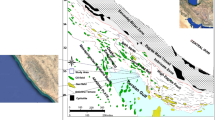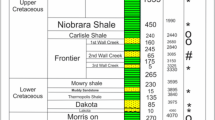Abstract
Investigating the quality of hydrocarbon reservoirs, especially carbonate reservoirs, is a very critical issue in the economic evaluation of the reservoirs. Therefore, we have tried to present a robust and practical formula for evaluating reservoirs quality. The novel Reservoir Petrophysical Index (RPI) based on well-logging data integration is presented in this research. Density, P-wave velocity, gamma ray, resistivity and effective porosity are inputs of the RPI. The RPI aims to distinguish the reservoir and non-reservoir units. The reservoir quality can effectively be evaluated by RPI. To study the performance of the RPI in a practical case, the RPI was calculated for the Iranian offshore oilfield data. The Iranian offshore oilfield is located in the Persian Gulf and on the east of the giant South Pars field. We selected three wells for evaluation of the RPI. The RPI was calculated for all wells, and we concluded that the data integration causes the discrimination of the different zones more accurately. The RPI's sensitivity to reservoir quality factors was evaluated, and we concluded that the various factors affect the RPI results. It was shown that the RPI sensitivity to the porosity and permeability is high. Thus, in non-reservoir zones where porosity and permeability are extremely low, RPI shows a sharp decrease, and the index increases with the increase of porosity and permeability in oil-saturated zones. Also, the effect of the saturation revealed in RPI results and the oil saturation affect the RPI. As a result, the rocks and fluids effects were considered. As the prototype reservoir to examine the proposed methodology, the Surmeh Formation in one of oilfields of Persian Gulf was successfully divided into six rock types based on the newly calculated RPI and Self Organizing Maps (SOM). Reservoir quality decreases from rock types 1 to 6. The use of RPI facilitates the interpretation of well-logging data in an easy, robust and quick way to address the heterogeneity of carbonate reservoirs.

















Similar content being viewed by others
Data availability
There is no permission to share the data of this article.
References
Al-Javad SN, Abd Ahmed M, Saleh AH (2020) Integrated reservoir characterization and quality analysis of the carbonate rock types, case study, southern Iraq. J Pet Explor Prod Technol 10(8):3157–3177. https://doi.org/10.1007/s13202-020-00982-6
Al-Jawad SN, Saleh AH (2020) Flow units and rock type for reservoir characterization in carbonate reservoir : case study, south of Iraq. J Pet Explor Prod Technol 10(1):1–20. https://doi.org/10.1007/s13202-019-0736-4
Al-mahrooqi S, Mookerjee A, Walton W, Scholten S, Archer R, Al-busaidi J, Al-busaidi H, Oman S (2011). Well Logging and Formation Evaluation Challenges in the Deepest Well in the Sultanate of Oman ( HPHT Tight Sand Reservoirs ). Soc Pet Eng J, 1–9.
Aminian K, Ameri S (2005) Application of artificial neural networks for reservoir characterization with limited data. J Petrol Sci Eng 49:212–222. https://doi.org/10.1016/j.petrol.2005.05.007
Anifowose F, Adeniye S, Abdulraheem A, Al-shuhail A (2016) Integrating seismic and log data for improved petroleum reservoir properties estimation using non-linear feature-selection based hybrid computational intelligence models. J Petrol Sci Eng 145:230–237. https://doi.org/10.1016/j.petrol.2016.05.019
Beigi M, Jafarian A, Javanbakht M, Wanas HA, Matten F, Tabatabaei A (2017) Facies analysis, diagenesis and sequence stratigraphy of the carbonate-evaporite succession of the Upper Jurassic Surmeh Formation: Impacts on reservoir quality (Salman Oil Field, Persian Gulf, Iran). J Afr Earth Sc 129:179–194
Chongwain GC, Osinowo OO, Ntamak-Nida MJ, Nkwanyang TL (2019) Lithological typing, depositional environment, and reservoir quality characterization of the “ M - Field”, offshore Douala Basin, Cameroon. J Pet Explor Prod Technol 9(3):1705–1721. https://doi.org/10.1007/s13202-019-0648-3
Dasgupta SN, Aminzadeh F (2013) Geophysics for Petroleum Engineers. Elsevier
Edwards DA, Brenner H, Karsh T (1994). Interfacial Transport Processes and Rheology,. In J Pet Explor Prod Technol (Vol. 10)
Farfour M, Yoon WJ, Kim J (2015) Seismic attributes and acoustic impedance inversion in interpretation of complex hydrocarbon reservoirs. J Appl Geophys 114:68–80. https://doi.org/10.1016/j.jappgeo.2015.01.008
Haijun Y, Sun SZ, Lulu C, Youjun X (2011). A new method of formation evaluation for fractured and caved carbonate reservoirs : A case study from the Lundong area , Tarim Basin , China. Pet.Sci., 446–454. https://doi.org/10.1007/s12182-011-0162-9
Jonge-anderson ID, Ma J, Wu X, Stow D (2022) Determining reservoir intervals in the Bowland Shale using petrophysics and rock physics models. Geophys J Int 228:39–65
Jurcic H, Plc INA, Cogelja Z (2012). Petrophysical Parameters Evaluation in Unconventional Reservoirs by Well Logging and Mud Logging Data Interactive Correlation Method. Soc Pet Eng
Kadkhodaie A, Kadkhodaie R,(2022a). Chapter 3 - Tight gas sandstones rock typing. In Kadkhodaie A, Kadkhodaie R (Ed.). Reservoir characterization of tight gas sandstones: exploration and development. (pp. 1–22). Elsevier. https://doi.org/10.1016/B978-0-323-90180-2.00010-4
Kadkhodaie A, Kadkhodaie R (2022b). Chapter 4 - Pore type and pore size distribution. In Kadkhodaie A, Kadkhodaie R (Ed.). Reservoir characterization of tight gas sandstones: exploration and development. (pp. 1–22). Elsevier. https://doi.org/10.1016/B978-0-323-90180-2.00010-4
Kadkhodaie A, Kadkhodaie R (2022c). Chapter 5 - Porosity and permeability evolution. In Kadkhodaie A, Kadkhodaie R (Ed.). Reservoir characterization of tight gas sandstones: exploration and development. (pp. 1–22). Elsevier. https://doi.org/10.1016/B978-0-323-90180-2.00010-4
Kazatchenko E, Mousatov A (2002). Primary and Secondary Porosity Estimation of Carbonate Formations Using Total Porosity and the Formation Factor. Soc Pet Eng
Kendalp CGSC, Bowen B, Alsharhan A, Cheong D, Stoudt D, Geology C, Box PO, Ain AI, Emirates UA (1991) Eustatic controls on carbonate facies in reservoirs, and seals associated with Mesozoic hydrocaron fields of the Arabian Gulf and the Gulf of Mexico. Marire Geolog 102:215–238
Lasemi Y, Jalilian AH (2010) The Middle Jurassic basinal deposits of the Surmeh Formation in the Central Zagros Mountains, southwest Iran : facies, sequence stratigraphy, and controls. Carbonates Evaporites 25:283–295. https://doi.org/10.1007/s13146-010-0032-3
Leisi A, Falahat R (2021) Investigation of some porosity estimation methods using seismic data in one of the south Iranian oil fields. J Pet Sci Res 31(119):88–97. https://doi.org/10.22078/pr.2021.4438.3007
Leisi A, Saberi MR (2022) Petrophysical parameters estimation of a reservoir using integration of wells and seismic data: a sandstone case study. Earth Sci Inf. https://doi.org/10.1007/s12145-022-00902-8
Li Y, Zhang T, Dai Z, Huang L, Xu Y, Wang X, Fang R, Zhang X, Li T (2020). Quantitative evaluation methods of tight reservoirs based on multi-feature fusion : A case study of the fourth member of Shahejie Formation in Liaohe Depression Yang Li a, Tingshan Zhang a, Zongyang Dai a, Lei Huang b, Yuxuan School of Geoscience and. J Pet Sci Eng https://doi.org/10.1016/j.petrol.2020.108090
Lim J (2005) Reservoir properties determination using fuzzy logic and neural networks from well data in offshore Korea. J Petrol Sci Eng 49:182–192. https://doi.org/10.1016/j.petrol.2005.05.005
Lucia, F. J. (2007). Carbonate Reservoir Characterization. springer.
Masoud M, Meddaugh WS, Masud ME (2020) Reservoir Characterization and Geostatistical Model of the Cretaceous and Cambrian-Ordovician Reservoir Intervals, Meghil Field, Sirte Basin. Society of Petroleum Engineers, Libya
Mohammed OK, Glover PWJ, Ll RE (2021). Reservoir quality estimation using a new ternary diagram approach applied to carbonate formations in north-western Iraq. J Pet Sci Eng 196(March 2020). https://doi.org/10.1016/j.petrol.2020.108024
Nizamuddin S, Hossain ME, Abdulazeez A, Hassan MR (2016). Permeability Prediction Based on Leaky-Capillary-Tubes Using Genetic. Soc Pet Eng
Ozkan A, Cumella SP, Milliken KL, Laubach SE (2011) Prediction of lithofacies and reservoir quality using well logs, Late Cretaceous Williams Fork Formation, Mamm Creek field, Piceance Basin, Colorado. Am Assoc Petr Geol Mem 95(10):1699–1723. https://doi.org/10.1306/01191109143
Qadri SMT, Islam A, Shalaby MR, El-Aal AKA (2021) Reservoir quality evaluation of the Farewell sandstone by integrating sedimentological and well log analysis in the Kupe South Field, Taranaki Basin - New Zealand. J Pet Explor Prod Technol 11(1):11–31. https://doi.org/10.1007/s13202-020-01035-8
Revil A, Jardani A, Sava P, Haas A (2015). The Seismoelectric Method, Theory and applications. Wiley Blackwell
Selley RC, Sonnenberg SA (2015) Elements of Petroleum Geology. Elsevier. https://doi.org/10.1016/B978-0-12-386031-6.09001-9
Sfidari E, Amini A, Kadkhodaie-ilkhchi A, Chehrazi A, Zamanzadeh SM (2018) Depositional facies, diagenetic overprints and sequence stratigraphy of the upper Surmeh reservoir (Arab Formation) of offshore Iran. J Afr Earth Sc. https://doi.org/10.1016/j.jafrearsci.2018.07.025
Sfidari E, Sharifi M, Amini A, Zamanzadeh SM, Kadkhodaie A (2020). Reservoir quality of the Surmeh ( Arab-D ) reservoir in the context of sequence stratigraphy in Salman Field , Persian Gulf. J Pet Sci Eng https://doi.org/10.1016/j.petrol.2020.108180
Shalaby MR, Binti Sapri SH, Islam A (2020) Integrated reservoir characterization and fluid flow distribution of the Kaimiro Formation, Taranaki Basin, New Zealand. J Pet Explor Prod Technol 10(8):3263–3279. https://doi.org/10.1007/s13202-020-01005-0
El Sharawy M, Nabawy B (2016). Determination of electrofacies using wireline logs based on multivariate statistical analysis for the Kareem Formation , Gulf of Suez , Egypt. Environ Earth Sci https://doi.org/10.1007/s12665-016-6214-0
Silva GM, Souza VDe, Davolio A, Schiozer DJ, Petr P (2020). Journal of Petroleum Science and Engineering Improving fluid modeling representation for seismic data assimilation in compositional reservoir simulation. J Pet Sci Eng 194(June), 107446 https://doi.org/10.1016/j.petrol.2020.107446
Tyler N, Major RP, Bebout DG, Kerans C, Lucia FJ, Ruppel SC, Holtz MH (1992) Styles of heterogeneity in dolomitized platform carbonate reservoirs : Examples from the Central Basin Platform of the Permian Basin, southwestern USA. J Petrol Sci Eng 6:301–339
Yang P, Sun SZ, Liu Y, Li H, Dan G, Jia H (2012). Origin and architecture of fractured-cavernous carbonate reservoirs and their influences on seismic amplitudes. The Leading Edge.
Acknowledgements
We express our gratitude to the unknown reviewers that helped us improve the quality of this research paper.
Funding
No funding was obtained for this study.
Author information
Authors and Affiliations
Contributions
All the authors had good and active cooperation in writing the article and the article has been completed with the participation of all the authors.
Saeed Aftab main writer of the manuscript and programmer. Ahsan Leisi was a co-author in the field of data analysis and visualization. Ali Kadkhodaie is supervisor and results interpreter.
Corresponding author
Ethics declarations
Competing interests
The authors declare no competing interests.
Consent for publication
We transfer to Springer Nature the non-exclusive publication rights and we warrant that our contribution is original and that we have full power to make this grant. We accept responsibility for releasing this material. This transfer of publication rights covers the non-exclusive right to reproduce and distribute the article, including reprints, translations, photographic reproductions, microform, electronic form (offline, online) or any other reproductions of similar nature.
Conflict of interest
There are no financial competitors related to this article.
Additional information
Publisher's note
Springer Nature remains neutral with regard to jurisdictional claims in published maps and institutional affiliations.
Rights and permissions
Springer Nature or its licensor (e.g. a society or other partner) holds exclusive rights to this article under a publishing agreement with the author(s) or other rightsholder(s); author self-archiving of the accepted manuscript version of this article is solely governed by the terms of such publishing agreement and applicable law.
About this article
Cite this article
Aftab, S., Leisi, A. & Kadkhodaie, A. Reservoir petrophysical Index (RPI) as a robust tool for reservoir quality assessment. Earth Sci Inform 16, 2457–2473 (2023). https://doi.org/10.1007/s12145-023-01049-w
Received:
Accepted:
Published:
Issue Date:
DOI: https://doi.org/10.1007/s12145-023-01049-w




